Martienssen W., Warlimont H. (Eds.). Handbook of Condensed Matter and Materials Data
Подождите немного. Документ загружается.

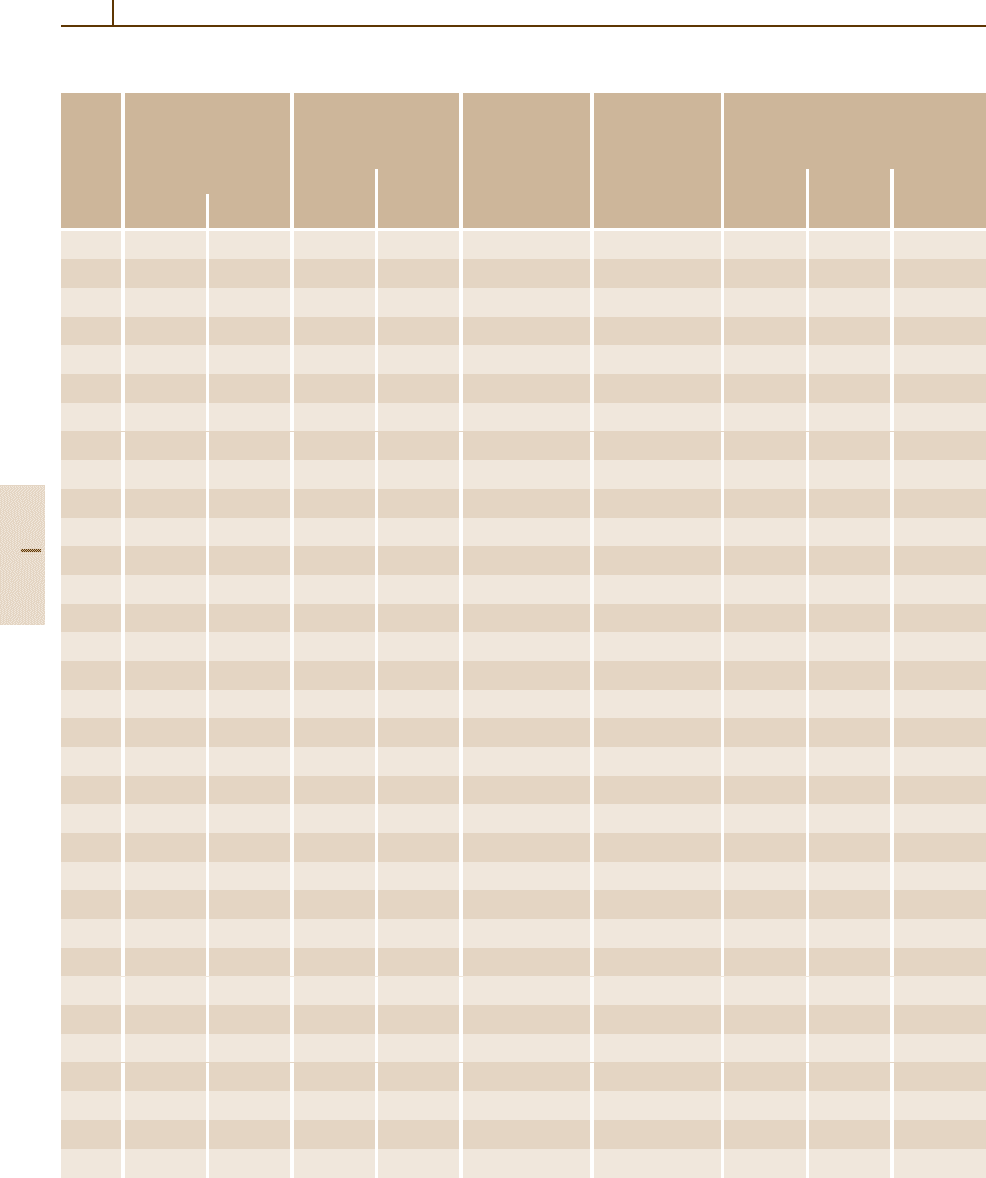
542 Part 3 Classes of Materials
Table 3.4-11 Characteristic data of technical specialty glasses, cont.
T
k100
Logarithm of Dielectric properties Refractive Stress- Classes of chemical
electrical volume at 1 MHz index n
d
optical stability against
resistivity and 25
◦
C (λ
d
= 587.6nm) coefficient K
( cm) at ε
r
tan δ Alkaline
(
◦
C) 250
◦
C 350
◦
C (10
−4
) (10
−6
mm
2
/N) Water Acid solution
330 9.6 7.6 6.6 11 1.556 3.1 3 2 3
215 7.4 5.9 5.7 80 1.488 3.8 3 4 3
− 12 10 4.3 10 1.466 5.2 3 3 3
375 10 8.3 4.9 22 1.487 3.6 3 4 3
660 − 12 6.1 11 1.538 3.3 1 3 2
630 − 11 6.6 15 1.547 2.7 1 2 2
585 − − 5.8 14 1.534 3.1 1 4 2
210 7.3 6.0 6.4 65 1.506 2.8 1 1 2
250 8.0 6.5 4.6 37 1.473 4.0 1 1 2
315 9.2 7.5 4.7 22 1.476 4.1 3 4 3
200 7.1 5.7 7.2 70 1.514 2.7 3 1 2
280 8.5 6.9 6.5 45 1.505 2.8 5 3 2
530 12 10 6.1 23 1.543 2.9 1 4 3
215 7.4 6.0 5.7 80 1.492 3.4 1 1 2
200 7.1 5.6 6.3 107 1.523 2.2 1 2 2
180 6.7 5.3 7.1 113 1.521 3.2 2 2 2
255 8.1 6.4 7.4 43 1.526 2.7 3 3 2
205 7.3 5.8 7.3 60 1.509 2.9 2 3 3
245 7.9 6.5 7.9 75 1.564 2.9 1–2 1–2 1
230 7.5 6.1 5.1 40 1.487 3.8 1 1 2
300 8.3 6.9 4.9 36 1.479 3.6 4 3 3
200 7.1 5.8 5.4 96 1.484 3.2 1 1 2
235 7.7 6.1 6.7 32 1.52 − 3 2 2
320 9.5 7.5 6.5 21 1.510 3.0 3 1–2 2
250 8.1 6.4 6.5 25 1.516 3.0 3 1 2
450 11 9.8 9.5 9 1.700 2.2 1 4 3
440 11 9.4 10.2 9 1.724 1.7 1 4 3
200 7.0 5.5 6.9 55 1.527 3.0 1 2 2
210 7.2 5.8 7.1 68 1.525 − 3 1 2
− − − 7.6 33 1.618 2.8 1 4 3
− 11.2 10.0 6.0 31 1.552 3.6 1 4 3
− − − 6.9 35 1.589 3.4 1 4 3
265 8.3 6.8 5.5 51 1.493 3.6 1 1 1
Part 3 4.4

Glasses 4.5 Optical Glasses 543
3.4.5 Optical Glasses
Historically, optical glasses were developed to optimize
imaging refractive optics in the visible part of the spec-
trum. With new mathematical tools, new light sources,
and new detectors, the resulting lens systems, which
used a combination of different glasses (or even some-
times crystalline materials), changed the requirement
from high versatility in terms of material properties
to homogeneity, precision, and reproducibility, and an
extended spectral range in the ultraviolet and infrared
regions; environmental aspects also became important.
Consequently, the high number of glass types has been
reduced.
3.4.5.1 Optical Properties
Refractive Index, Abbe Value, Dispersion,
and Glass Designation
The most common identifying features used for char-
acterizing an optical glass are the refractive index n
d
Table 3.4-12 Wavelengths of a selection for frequently used spectral lines
Wavelength (nm) Designation Spectral line used Element
2325.42 Infrared mercury line Hg
1970.09 Infrared mercury line Hg
1529.582 Infrared mercury line Hg
1060.0 Neodymium glass laser Nd
1013.98 t Infrared mercury line Hg
852.11 s Infrared cesium line Cs
706.5188 r Red helium line He
656.2725 C Red hydrogen line H
643.8469 C
Red cadmium line Cd
632.8 Helium–neon gas laser He–Ne
589.2938 D Yellow sodium line (center of the double line) Na D
587.5618 d Yellow helium line He
546.0740 e Green mercury line Hg
486.1327 F Blue hydrogen line H
479.9914 F
Blue cadmium line Cd
435.8343 g Blue mercury line Hg
404.6561 h Violet mercury line Hg
365.0146 i Ultraviolet mercury line Hg
334.1478 Ultraviolet mercury line Hg
312.5663 Ultraviolet mercury line Hg
296.7278 Ultraviolet mercury line Hg
280.43 Ultraviolet mercury line Hg
248.00 Excimer laser KrF
248.35 Ultraviolet mercury line Hg
194.23
193.00 Excimer laser ArF
in the middle range of the visible spectrum, and the
Abbe value ν
d
= (n
d
−1)/(n
F
−n
C
) as a measure of
the dispersion. The difference n
F
−n
C
is called the
principal dispersion. The symbols have subscripts that
identify spectral lines that are generally used to deter-
mine refractive indices; these spectral lines are listed in
Table 3.4-12.
The quantities n
e
and ν
e
= (n
e
−1)/(n
F
−n
C
)
based on the e-lineare usually used for specifying optical
components.
For the comparison of glass types from different
manufacturers, an abbreviated glass code is defined
in the following way: the first three digits correspond
to n
d
−1, the second three digits represent the Abbe
value ν
d
, and, after a dot, three more digits characterize
the density (see Table 3.4-13).
Glasses can be grouped into families in an
n
d
/ν
d
Abbe diagram (Fig. 3.4-25). These glass families
differ in chemical composition as shown in Fig. 3.4-26.
Part 3 4.5
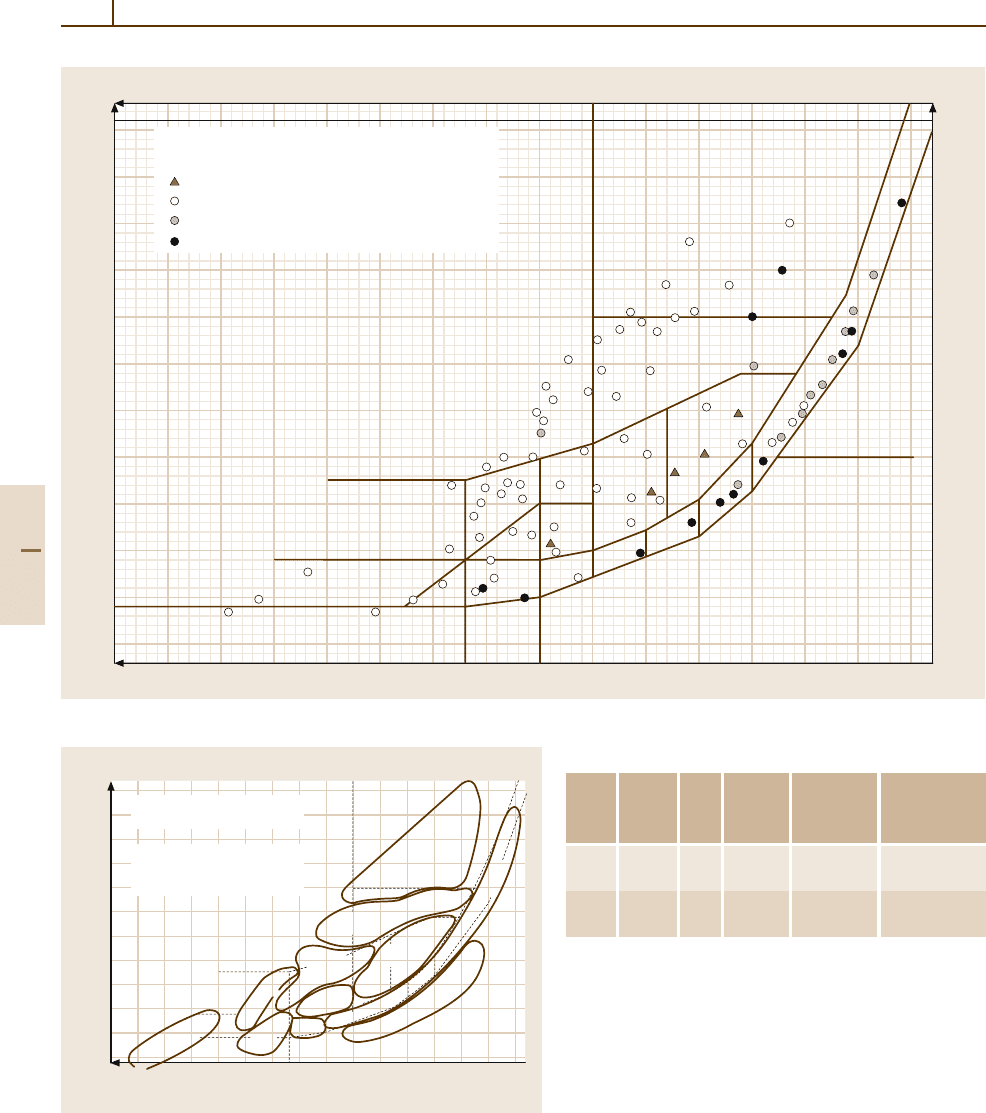
544 Part 3 Classes of Materials
2.00
1.95
1.90
1.85
1.80
1.75
1.70
1.65
1.60
1.55
1.50
1.45
n
d
v
d
2.00
1.95
1.90
1.85
1.80
1.75
1.70
1.65
1.60
1.55
1.50
1.45
n
d
v
d
90 85 80 75 70 65 60 55 55 45 40 35 30 25 20
90 85 80 75 70 65 60 55 55 45 40 35 30 25 20
Description of symbols
All glasses except short flint glasses (KZFS)
KZFS
Only N-type (lead-free and arsenic-free type)
N-type and conventional type
Conventional type
Circles
LASF
LAF
BASF
BAF
SSK
LAK
BALF
KF
LLF
LF
F
BAK
K
BK
SK
PSK
PK
FK
SF
51
52 A
51
5
10
7
3
11
5
14
16
15
4
2
10
53
21
7
22
12
9
14
8
34
10
3
35
2
33 A
34
21
44
32
33
36
43
41
40
45
9
31
46
2
5
8
52
3
4
4
11
51
10
1
9
10
5
2
ZK7
7
1
4
4
2
5
5
2
12
64
7
66
57
6
56
11
14
4
10
1
64
15
8
5
19
2
2
4
5
5
Fig. 3.4-25 Abbe diagram of glass families
2.00
1.95
1.90
1.85
1.80
1.75
1.70
1.65
1.60
1.55
1.50
1.45
95 90 85 80 75 70 65 60 55 50 45 40 35 30 25 20
Refractive index n
d
KzF glasses: SiO
2
-Sb
2
O
3
-B
2
O
3
KzFS glasses: B
2
O
3
-PbO-Al
2
O
2
B
2
O
3
-La
2
O
3
-M
m
O
n
(B
2
O
3
,SiO
2
)-
La
2
O
3
-MO
(SiO
2
,B
2
O
3
)
-BaO-PbO
SiO
2
-B
2
O
3
-
BaO
P
2
O
5
-
Al
2
O
3
-
MO-
(F
2
-O)
P
2
O
5
-
Al
2
O
3
-
MO-
B
2
O
3
SO
2
-
B
2
O
3
-
M
2
O
SiO
2
-
BaO-M
2
O
SiO
2
-PbO
-M
2
O
SiO
2
,
B
2
O
3
-
M
2
O-MO
SiO
2
-
M
2
O-
TiO
2-
(F
2
-O)
SiO
2
-
PbO-
M
2
O
Abbe number
Ψ
d
M
m
O
n
: ZrO
2
, Ta
2
O
5
, Nb
2
O
5
, ...
MO: MgO, CaO, SrO, BaO, ZnO
M
2
O: Li
2
O, Na
2
O, K
2
O, Cs
2
O
Fig. 3.4-26 Abbe diagram showing the chemical composition of
the glass families
Table 3.4-13 Examples of glass codes
Glass n
d
ν
d
Density Glass code Remarks
type
(gcm
−3
)
N-SF6 1.80518 25.36 3.37 805 254.337 Lead- and ar-
senic-free glass
SF6 1.80518 25.43 5.18 805254.518 Classical lead
silicate glass
The designation of each glass type here is composed of
an abbreviated family designation and a number. The
glass families are arranged by decreasing Abbe value in
the data tables (Table 3.4-14).
Table 3.4-14 gives an overview of the preferred
optical glasses from Schott, Hoya, and Ohara. The
glass types are listed in order of increasing refractive
index n
d
.
Part 3 4.5
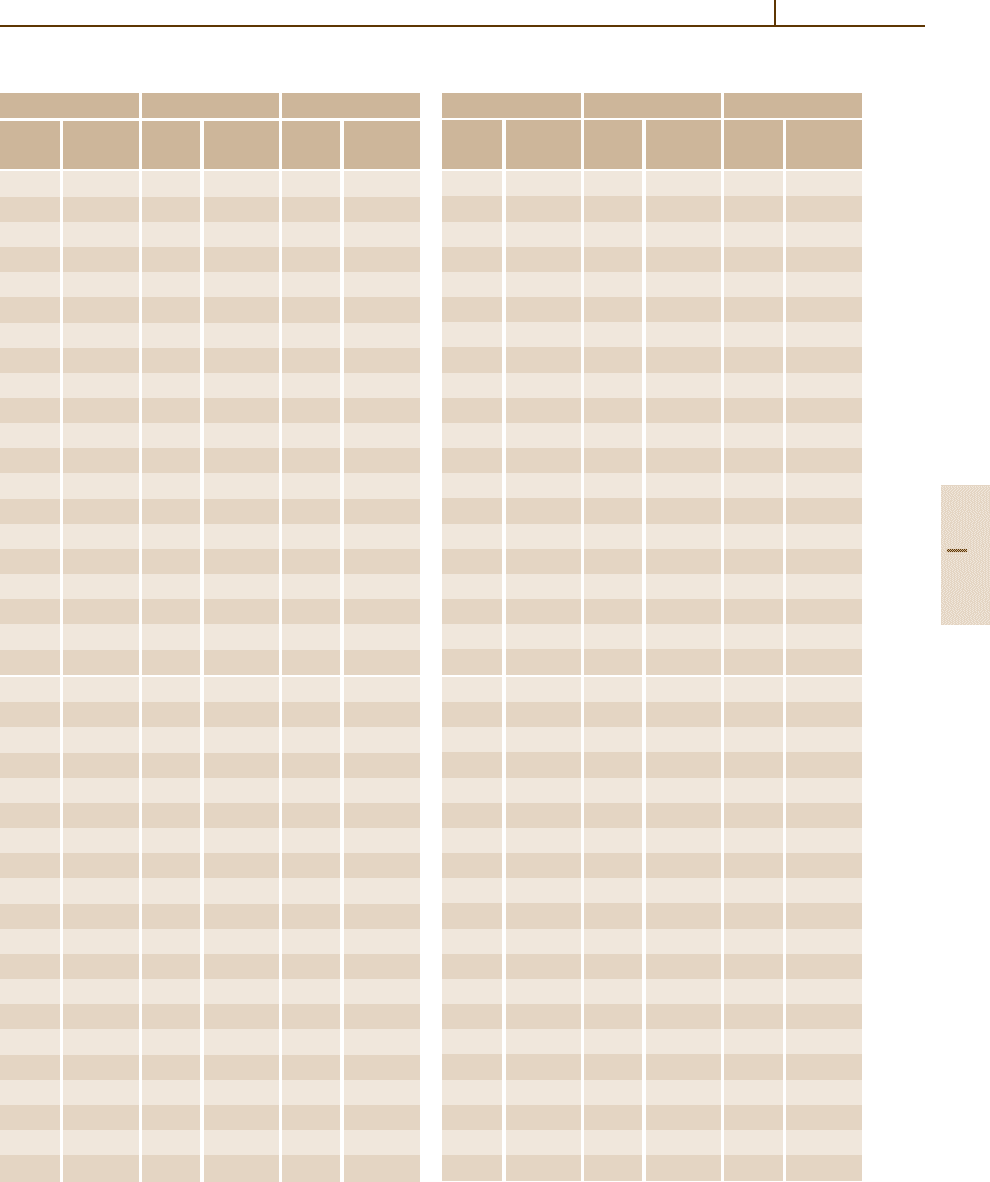
Glasses 4.5 Optical Glasses 545
Table 3.4-14 Comparison of the preferred optical glasses from different manufacturers
Schott Hoya Ohara
Code Glass Code Glass Code Glass
type type type
434950 N-FK56
439950 S-FPL53
456903 S-FPL52
487704 N-FK5 487704 FC5 487702 S-FSL5
487845 N-FK51
497816 N-PK52 497816 FCD1 497816 S-FPL51
498670 N-BK10
501564 K10
508612 N-ZK7
511604 K7
517522 CF6
517524 E-CF6 517524 S-NSL36
517642 N-BK7 517642 BSC7 516641 S-BSL7
517696 S-APL1
518590 E-C3 518590 S-NSL3
521526 SSL5
522595 N-K5
522598 S-NSL5
523515 N-KF9
529517 SSL2
529770 N-PK51
532488 N-LLF6 532488 FEL6
532489 E-FEL6 532489 S-TIL6
540597 N-BAK2 540595 S-BAL12
541472 E-FEL2 541472 S-TIL2
541472 FEL2
547536 N-BALF5
548458 LLF1 548458 FEL1
548458 N-LLF1 548458 E-FEL1 548458 S-TIL1
551496 SbF1
552635 N-PSK3
558542 N-KZFS2
560612 S-BAL50
564608 N-SK11 564607 EBaCD11 564607 S-BAL41
567428 FL6 567428 PBL26
569561 N-BAK4 569563 BaC4 569563 S-BAL14
569713 N-PSK58
571508 S-BAL2
571530 S-BAL3
573576 N-BAK1 573578 S-BAL11
Schott Hoya Ohara
Code Glass Code Glass Code Glass
type type type
575415 S-TIL27
580537 N-BALF4
581409 N-LF5 581407 E-FL5 581407 S-TIL25
581409 LF5 581409 FL5
583465 N-BAF3 583464 BAM3
583594 BaCD12 583594 S-BAL42
589613 N-SK5 589613 BaCD5 589612 S-BAL35
592683 N-PSK57
593353 S-FTM16
594355 FF5
596392 E-F8 596392 S-TIM8
596392 F8
603380 E-F5 603380 S-TIM5
603380 F5 603380 F5
603606 N-SK14 603606 BaCD14 603607 S-BSM14
603655 S-PHM53
606439 N-BAF4 606437 S-BAM4
607567 N-SK2 607568 BaCD2 607568 S-BSM2
609464 N-BAF52
613370 F3 613370 PBM3
613443 KZFSN4 613443 ADF10 613443 BPM51
613445 N-KZFS4
613586 N-SK4 613587 BaCD4 613587 S-BSM4
614550 BSM9
617366 F4
617628 S-PHM51
618498 N-SSK8 618498 S-BSM28
618634 PCD4 618634 S-PHM52
620364 N-F2 620363 E-F2 620363 S-TIM2
620364 F2 620364 F2
620603 N-SK16 620603 BaCD16 620603 S-BSM16
620622 ADC1
620635 N-PSK53
621359 TIM11
621603 SK51
622532 N-SSK2 622532 BSM22
623569 N-SK10 623570 EBaCD10 623570 S-BSM10
623580 N-SK15 623582 BaCD15 623582 S-BSM15
624470 BaF8
Part 3 4.5
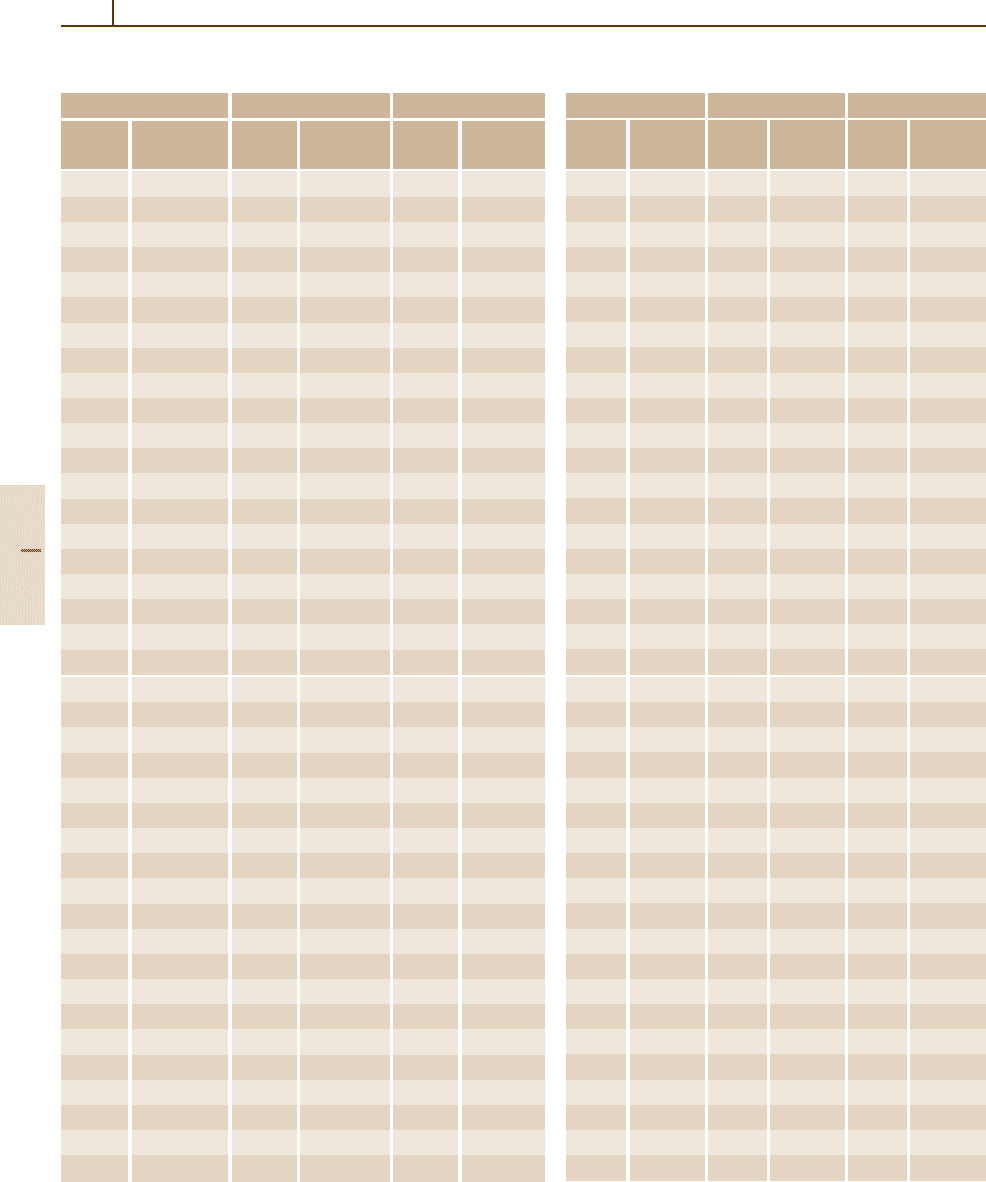
546 Part 3 Classes of Materials
Table 3.4-14 Comparison of the preferred optical glasses from different manufacturers, cont.
Schott Hoya Ohara
Code Glass Code Glass Code Glass
type type type
626357 F1
626357 E-F1 626357 S-TIM1
639421 N-KZFS11
639449 S-BAM12
639554 N-SK18 639554 BaCD18 639554 S-BSM18
640345 E-FD7 640345 S-TIM27
640601 N-LAK21 640601 LaCL60 640601 S-BSM81
641569 S-BSM93
643584 S-BSM36
648339 SF2 648339 FD2
648338 E-FD2 648338 S-TIM22
649530 E-BaCED20 649530 S-BSM71
651559 N-LAK22
651562 LaCL2 651562 S-LAL54
652449 N-BAF51
652585 N-LAK7 652585 LaC7 652585 S-LAL7
654396 KZFSN5 654396 ADF50 654397 BPH5
658509 N-SSK5 658509 BaCED5 658509 S-BSM25
658573 S-LAL11
664360 N-BASF2
667330 S-TIM39
667484 BaF11 667483 S-BAH11
670393 BAH32
670471 N-BAF10 670473 BaF10 670473 S-BAH10
670573 S-LAL52
673322 N-SF5 673321 E-FD5 673321 S-TIM25
673322 SF5 673322 FD5
678507 LaCL9 678507 S-LAL56
678549 LAKL12
678552 N-LAK12 678553 LaC12 678553 S-LAL12
689312 N-SF8 689311 E-FD8 689311 S-TIM28
689312 FD8
691547 N-LAK9 691548 LaC9 691548 S-LAL9
694508 LaCL5 694508 LAL58
694533 LAKN13 694532 LaC13 694532 S-LAL13
695422 S-BAH54
697485 LaFL2 697485 LAM59
697554 N-LAK14 697555 LaC14 697555 S-LAL14
697565 S-LAL64
Schott Hoya Ohara
Code Glass Code Glass Code Glass
type type type
699301 N-SF15 699301 E-FD15 699301 S-TIM35
699301 SF15 699301 FD15
700481 S-LAM51
702412 BaFD7 702412 S-BAH27
704394 NBASF64
706303 N-SF64
713538 N-LAK8 713539 LaC8 713539 S-LAL8
717295 N-SF1 717295 E-FD1
717295 SF1 717295 FD1 717295 PBH1
717480 N-LAF3 717480 LaF3 717479 S-LAM3
720347 BPH8
720420 LAM58
720437 S-LAM52
720460 LAM61
720506 N-LAK10 720504 LaC10 720502 S-LAL10
722292 S-TIH18
724381 NBASF51 723380 S-BAH28
724381 BASF51 724381 BaFD8
726536 S-LAL60
728284 SF10 728284 FD10
728285 N-SF10 728285 E-FD10 728285 S-TIH10
729547 N-LAK34 729547 TaC8 729547 S-LAL18
734515 TaC4 734515 S-LAL59
740283 PBH3W
741276 FD13 740283 PBH3
741278 E-FD13 741278 S-TIH13
741527 TaC2 741527 S-LAL61
743492 N-LAF35 743493 NbF1 743493 S-LAM60
744447 N-LAF2 744447 LaF2 744448 S-LAM2
750350 LaFN7 750353 LaF7 750353 LAM7
750350 N-LAF7
754524 N-LAK33 755523 TaC6 755523 S-YGH51
755276 N-SF4 755275 E-FD4 755275 S-TIH4
755276 SF4 755276 FD4
756251 TPH55
757478 NbF2 757478 S-LAM54
762265 N-SF14 762265 FD140 762265 S-TIH14
762265 SF14 762266 FD14
762401 S-LAM55
772496 N-LAF34 772496 TaF1 772496 S-LAH66
Part 3 4.5
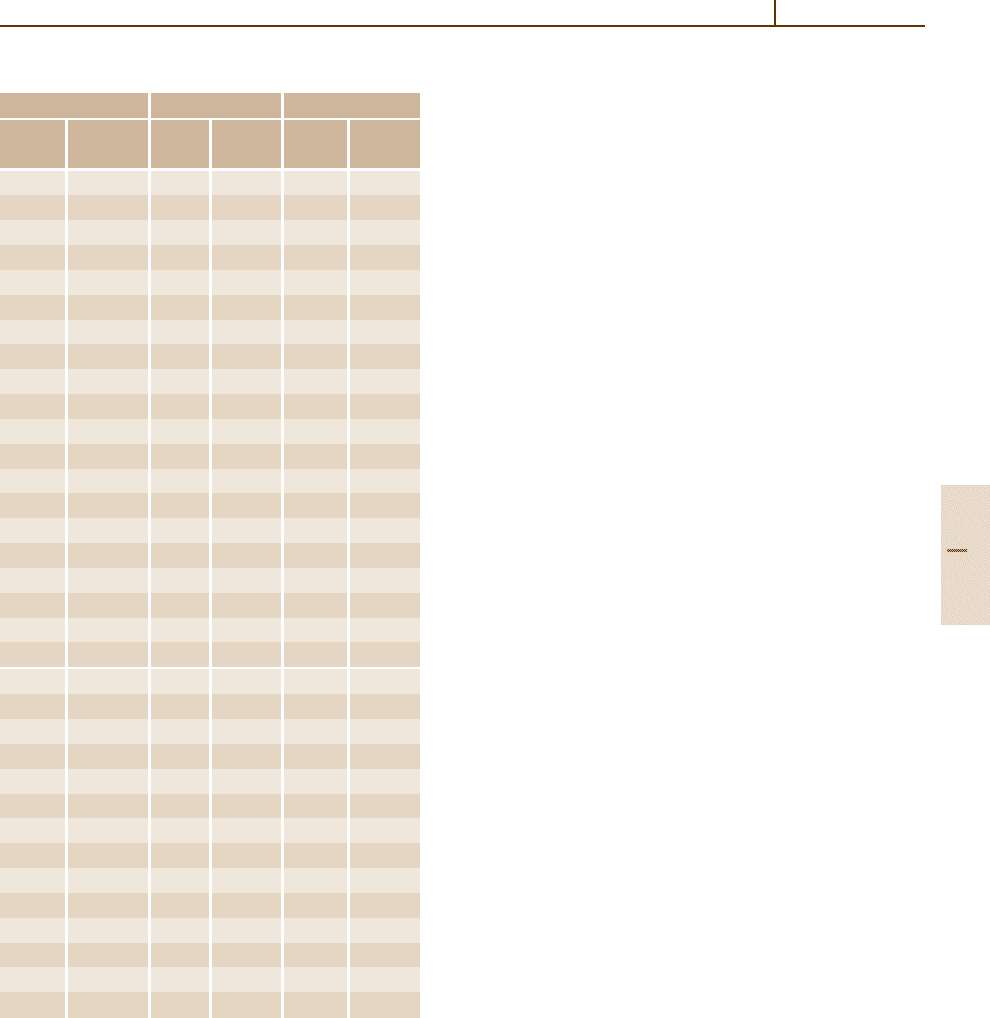
Glasses 4.5 Optical Glasses 547
Table 3.4-14 Comparison of preferred optical glasses, cont.
Schott Hoya Ohara
Code Glass Code Glass Code Glass
type type type
785258 SF11 785258 FD11
785258 FD110 785257 S-TIH11
785261 SF56A
785261 N-SF56 785261 FDS30 785263 S-TIH23
786441 N-LAF33 786439 NBFD11 786442 S-LAH51
787500 S-YGH52
788475 N-LAF21 788475 TA F4 788474 S-LAH64
794454 N-LAF32 795453 S-LAH67
800423 N-LAF36 800423 NBFD12 800422 S-LAH52
801350 N-LASF45 801350 S-LAM66
804396 S-LAH63
804466 N-LASF44 804465 TAF3 804466 S-LAH65
805254 N-SF6 805254 FD60 805254 S-TIH6
805254 SF6 805254 FD6
805396 NBFD3
806333 NBFD15
806407 N-LASF43 806407 NBFD13 806409 S-LAH53
808228 S-NPH1
816445 TAFD10 816444 S-LAH54
816466 TAF5 816466 S-LAH59
834374 N-LASF40 834373 NBFD10 834372 S-LAH60
835430 N-LASF41 835430 TAFD5 835427 S-LAH55
847238 N-SF57 847238 FDS90 847238 S-TIH53
847236 SFL57
847238 SF57 847238 FDS9 847238 TIH53
850322 LASFN9
874353 S-LAH75
881410 N-LASF31
883408 TAFD30 883408 S-LAH58
901315 N-LASF46 901315 LAH78
923209 SF66 923209 E-FDS1
923213 PBH71
1003283 S-LAH79
1022291 N-LASF35
Formulas for Optical Characterization
The characterization of optical glasses through the re-
fractive index and Abbe value alone is insufficient for
high-quality optical systems. A more accurate descrip-
tion of the properties of a glass can be achieved with the
aid of the relative partial dispersion.
Relative Partial Dispersion. The relative partial disper-
sion P
x,y
for the wavelengths x and y based on the blue F
hydrogen line and red C hydrogen line is given by
P
x,y
= (n
x
−n
y
)/(n
F
−n
C
). (4.15)
The corresponding value based on the blue F
cadmium
line and red C
cadmium line is given by
P
x,y
= (n
x
−n
y
)/(n
F
−n
C
). (4.16)
Relationship Between the Abbe Value and the Rel-
ative Partial Dispersion.
A linear relationship exists
between the Abbe value and the relative partial disper-
sion for what are known as “normal glasses”:
P
x,y
≈ a
xy
+b
xy
ν
d
. (4.17)
Deviation from the “Normal Line”. All other glasses
deviate from the “normal line” defined by ∆ P
x,y
.Forthe
selected wavelength pairs the ∆P-value are calculated
from the following equations:
P
x,y
= a
xy
+b
xy
ν
d
+∆P
x,y
, (4.18)
∆P
C,t
= (n
C
−n
t
)/(n
F
−n
C
)
−(0.5450 +0.004743ν
d
), (4.19)
∆P
C,s
= (n
C
−n
s
)/(n
F
−n
C
)
−(0.4029 +0.002331ν
d
), (4.20)
∆P
F,e
= (n
F
−n
e
)/(n
F
−n
C
)
−(0.4884 −0.000526ν
d
), (4.21)
∆P
g,F
= (n
g
−n
F
)/(n
F
−n
C
)
−(0.6438 −0.001682ν
d
), (4.22)
∆P
i,g
= (n
i
−n
g
)/(n
F
−n
C
)
−(1.7241 −0.008382ν
d
). (4.23)
The “normal line” has been determined based on value
pairs of glasses types K7 and F2. The term ∆P
x,y
quan-
titatively describes the deviation of the behavior of the
dispersion from that of “normal glasses”.
The Sellmeier dispersion formula for the refractive
index,
n
2
(λ) −1 = B
1
λ
2
/(λ
2
−C
1
) + B
2
λ
2
/(λ
2
−C
2
)
+ B
3
λ
2
/(λ
2
−C
3
), (4.24)
can be derived from classical dispersion theory with
the assumption of three resonance wavelengths. It is
valid only for interpolation within a spectral region
in which the refractive index has been measured. The
vacuum wavelength λ in µm has to be used. The pre-
cision of the calculation achievable is generally better
than 1× 10
−5
.
Part 3 4.5
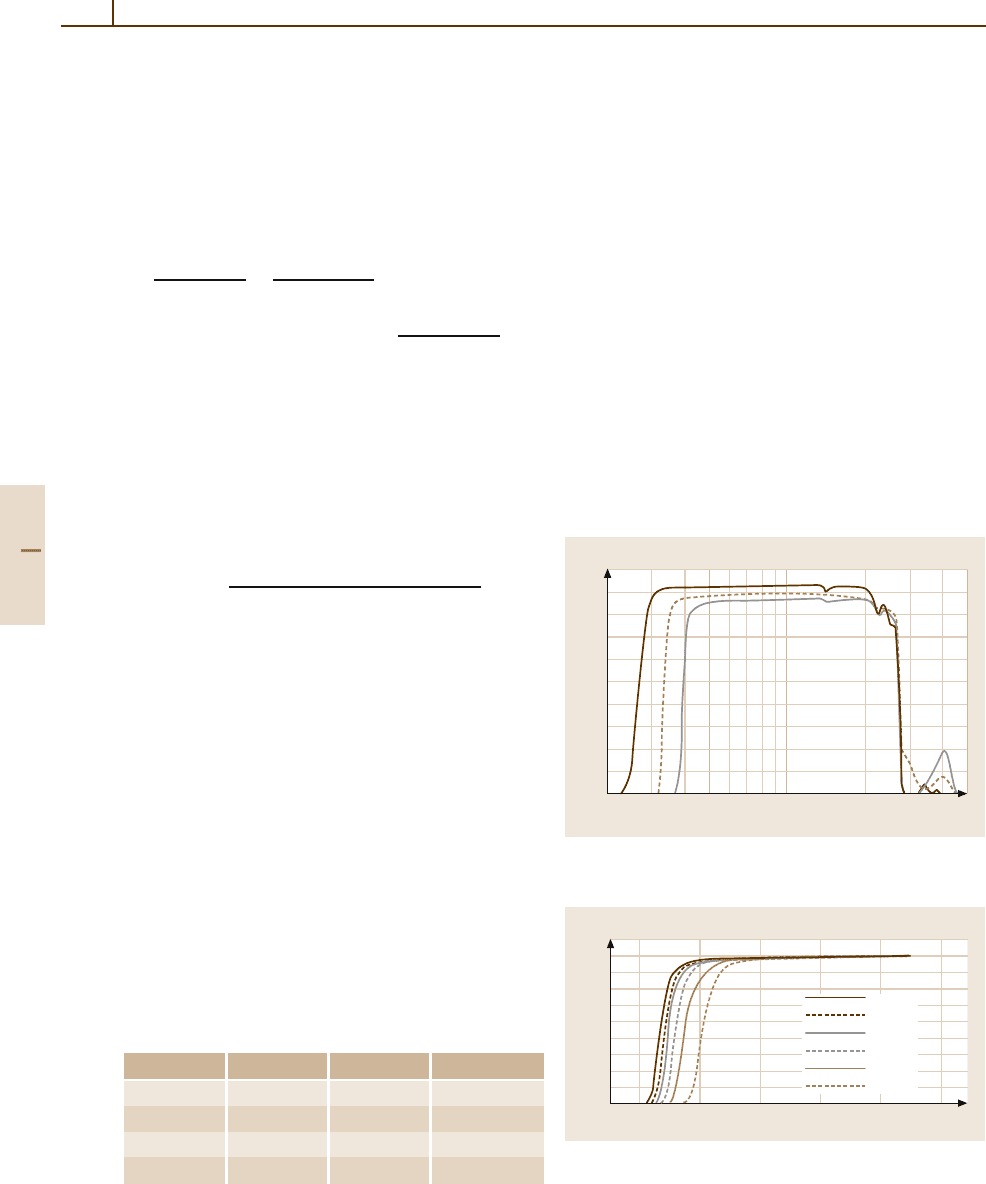
548 Part 3 Classes of Materials
Temperature Dependence of the Refractive Index. The
refractive index is also dependent on temperature. This
temperature dependence is represented by ∆n
rel
/∆T for
an air pressure of 1013.3hPaand∆n
abs
/∆T in vacuum.
The following equation is derived from the Sellmeier
formula and is valid with the given coefficients in the
temperature range −40
◦
C < T < +80
◦
C and within the
wavelength range 435.8nm<λ<643.8nm:
dn
abs
(λ, T )
dT
=
n
2
(λ, T
0
) −1
2n(λ, T
0
)
×
D
0
+2D
1
∆T +3D
2
∆T
2
+
E
0
+2E
1
∆T
λ
2
−λ
2
TK
,
(4.25)
where ∆T is the temperature difference in
◦
C from
20
◦
C, and λ
TK
is an effective resonance wavelength.
The changes in the refractive index and Abbe value
caused by a change in the annealing rate are given by
n
d
(h
x
) = n
d
(h
0
) +m
nd
log(h
x
/h
0
), (4.26)
ν
d
(h
x
) = ν
d
(h
0
) +m
νd
log(h
x
/h
0
), (4.27)
m
νd
=
m
nd
−ν
d
(h
0
)m
nF−nC
(n
F
−n
C
) +2m
nF−nC
log(h
x
/h
0
)
,
(4.28)
where h
0
is the original annealing rate in
◦
C/h, h
x
is
the new annealing rate in
◦
C/h, m
nd
is the annealing
coefficient for the refractive index (Table 3.4-15), m
νd
is
the annealing coefficient for the Abbe value and m
nF−nC
is the annealing coefficient for the principal dispersion.
The last three quantities depend on the glass type.
The measurement accuracy of the Abbe value can
be calculated using
σ(ν
d
) ≈ σ(n
F
−n
C
)ν
d
/(n
F
−n
C
). (4.29)
The accuracy of precision measurements of the refrac-
tive indices is better than ±1×10
−5
, and the accuracy
of the dispersion is ±3×10
−6
. In the infrared wave-
length range above 2 µm, the corresponding accuracies
are ±2×10
−5
and ±5×10
−6
.
Table 3.4-15 Annealing coefficients for selected glass
types
Glass type m
nd
m
nF−nC
m
νd
N-BK7 −0.00087 −0.000005 −0.0682
N-FK51 −0.00054 −0.000002 −0.0644
SF6 −0.00058 +0.000035 −0.0464
N-SF6 −0.0025 −0.000212 +0.0904
Transmission. The transmittance of glasses is limited
by electronic excitiations and light scattering in the UV,
by vibronic excitations in the IR, and by reflections and
impurity absorptions within the transmission window
(in the visible part of the spectrum): Fig. 3.4-27. The UV
absorption edge is temperature dependent. An example
is shown in Fig. 3.4-28.
Spectral Internal Transmittance. The spectral internal
transmittance is given by
τ
iλ
= Φ
eλ
/Φ
iλ
, (4.30)
where Φ
iλ
is the incident light intensity and Φ
eλ
is the
intensity at the exit.
Spectral Transmission. The spectral transmission is
given by
τ
λ
= τ
iλ
P
λ
, (4.31)
where P
λ
is the reflection factor.
Wavelength (nm)
Transmission (%)
100
90
80
70
60
50
40
30
20
10
0
200 500 1000 5000
Fig. 3.4-27 Transmission of three glasses for a thickness
of 5 mm: Brown line FK5; dashed line SF2; gray line SF11
Wavelength (µm)
Transmission (%)
100
80
60
40
20
0
300 400 500
600
700 800
20 °C
100 °C
200 °C
300 °C
400 °C
500 °C
Fig. 3.4-28 Influence of temperature on the UV transmis-
sion of glass F2 for a thickness of 10 mm
Part 3 4.5

Glasses 4.5 Optical Glasses 549
Fresnel Reflectivity. Fora light beam striking the surface
perpendicularly, the Fresnel reflectivity is, independent
of polarization,
R =(n −1)
2
/(n +1)
2
. (4.32)
Reflection Factor. The reflection factor, taking account
of multiple reflection, is given by
P = (1 − R)
2
/(1 −R
2
) = 2n/(n
2
+1), (4.33)
where n is the refractive index for the wavelength λ.
Conversion of Internal Transmittance to Another
Layer Thickness.
The conversion of data for internal
transmittance to another sample thickness is accom-
plished by the use of the equation
log τ
i1
/ log τ
i2
= d
1
/d
2
(4.34)
or τ
i2
= τ
(d
2
/d
1
)
i1
, (4.35)
where τ
i1
and τ
i2
are the internal transmittances for the
thicknesses d
1
and d
2
, respectively.
Stress Birefringence. The change in optical path length
for existing stress birefringence can be calculated from
∆s = (n
−n
⊥
)d = (K
−K
⊥
)dσ = Kdσ, (4.36)
where K is the stress optical coefficient, dependent on
the glass type, d is the length of the light path in the sam-
ple, and σ is the mechanical stress (positive for tensile
stress). If K is given in 10
−6
mm
2
/N, d isgiveninmm,
and σ is measured in MPa =N/mm
2
, ∆s comes out in
mm.
For the Pockels glass SF57, the stress optical coeffi-
cient K is close to 0 in the visible wavelength range.
Homogeneity. The homogeneity of the refractive index
of a samplecan be measured from theinterferometrically
measured wavefront deformation using the equation
∆n = ∆W/2d
= ∆W(λ) ×633 ×10
−6
/(2d[mm]), (4.37)
where the wavefront deformation is in units of the
wavelength and is measured using a test wavelength
of 633 nm (He–Ne laser); ∆W is the wavefront de-
formation for double beam passage; and d is the
thickness of the test piece. With special effort during
melting and careful annealing, it is possible to pro-
duce pieces of glass having high homogeneity. The
refractive-index homogeneity achievable for a given
glass type depends on the volume and the form of
the individual glass piece. Values of ±5×10
−7
(class
H5) cannot be achieved for all dimensions and glass
types.
The properties of a selection of optical glasses are
collected together in Table 3.4-16.
Internal Transmittance and Color Code
The internal transmittance, i. e. the light transmission
excluding reflection losses, is closely related to the
optical position of the glass type, according to gen-
eral dispersion theory. This can be achieved, however,
only by using purest raw materials and costly melting
technology.
The internal transmittance of lead- and arsenic-
free glasses, in which lead has been replaced by other
elements, is markedly less than in the lead-containing
predecessor glasses.
The limit of the transmission range of optical glasses
towards the UV area is of special interest and is
characterized by the position and slope of the UV ab-
sorption curve, which is described by a color code.
The color code gives the wavelengths λ
80
and λ
5
,at
which the transmission (including reflection losses) is
0.80 and 0.05, respectively, at 10 mm thickness. The
color code 33/30 means, for example, λ
80
= 330 nm
and λ
5
= 300 nm.
3.4.5.2 Chemical Properties
The composition of optical glasses includes elements
that reduce chemical resistance. For these glasses,
five test methods are used to assess the chemical
behavior of polished glass surfaces in typical appli-
cations. The test methods and classification numbers
take the place of those described for technical glasses
in Sect. 3.4.4. Data for optical properties are found in
Table 3.4-16c.
Climatic Resistance (ISO/WD 13384): Division
into Climatic Resistance Classes CR 1–4
Climatic resistance describes the behavior of optical
glasses at high relative humidity and high temperatures.
In the case of sensitive glasses, a cloudy film can appear
that generally cannot be wiped off.
The classifications are based on the increase in trans-
mission haze ∆H after a 30h test period. The glasses in
class CR 1 display no visible attack after being subjected
to 30 h of climatic change.
Under normal humidity conditions, no surface attack
should be expected during the fabrication and storage of
Part 3 4.5

550 Part 3 Classes of Materials
optical glasses in class CR 1. On the other hand, the
fabrication and storage of optical glasses in class CR 4
should be done with caution because these glasses are
very sensitive to climatic influences.
Stain Resistance: Division into Stain Resistance
Classes FR 0–5
The test procedure gives information about possible
changes in the glass surface (stain formation) under
the influence of lightly acidic water (for example per-
spiration and acidic condensates) without vaporization.
Two test solutions are used. Test solution I is a standard
acetate solution with pH = 4.6, for classes FR 0 to 3.
Test solution II is a sodium acetate buffer solution with
pH = 5.6, for classes FR 4 and FR 5.
Interference color stains develop as a result of de-
composition of the surface of the glass by the test
solution. The measure used for classifying the glasses
is the time that elapses before the first brown–blue stain
occurs at a temperature of 25
◦
C.
Stain resistance class FR 0 contains all glasses that
exhibit virtually no interference colors even after 100 h
of exposure to test solution I.
Glasses in classification FR 5 must be handled with
particular care during processing.
Acid Resistance (ISO 8424: 1987): Division into
Acid Resistance Classes SR 1–4, 5, and 51–53
Acid resistance classifies the behavior of optical glasses
that come into contact with large quantities of acidic
solutions (from a practical standpoint, these may be
perspiration, laminating substances, carbonated water,
etc.).
The time t required to dissolve a layer with a thick-
ness of 0.1 µm serves as a measure of acid resistance.
Two aggressive solutions are used in determining acid
resistance. A strong acid (nitric acid, c = 0.5mol/l,
pH =0.3) at 25
◦
C is used for the more resistant glass
types. For glasses with less acid resistance, a weakly
acidic solution with a pH value of 4.6 (standard acetate)
is used, also at 25
◦
C.
Alkali Resistance (ISO 10629) and Phosphate
Resistance (ISO 9689): Division into Alkali
Resistance Classes AR 1–4 and Phosphate
Resistance Classes PR 1–4
These two test methods indicate the resistance to aque-
ous alkaline solutions in excess and use the same
classification scheme. The alkali resistance indicates the
sensitivity of optical glasses when they are in contact
with warm, alkaline liquids, such as cooling liquids used
in grinding and polishing processes. The phosphate re-
sistance describes the behavior of optical glasses during
cleaning with phosphate-containing washing solutions
(detergents).
The alkali resistance class AR is based on the time
required to remove a layer of glass of thickness 0.1 µmin
an alkaline solution (sodium hydroxide, c = 0.01 mol/l,
pH = 12) at a temperature of 50
◦
C.
The phosphate resistance class PR is based on the
time required to remove a layer of glass of thickness
0.1 mm in an alkaline phosphate-containing solution
(pentasodium triphosphate, Na
5
P
3
O
10
, c = 0.01 mol/l,
pH =10) at a temperature of 50
◦
C. The thickness is cal-
culated from the weight loss per unit surface area and
the density of the glass.
3.4.5.3 Mechanical Properties
Young’s Modulus and Poisson’s Ratio
The adiabatic Young’s modulus E (in units of
10
3
N/mm
2
) and Poisson’s ratio µ have been deter-
mined at room temperature and at a frequency of 1 kHz
using carefully annealed test samples. Data are listed in
Table 3.4-16c. In most cases, the values decrease slightly
with temperature.
The torsional modulus can be calculated from
G = E/[2(1 +µ)] .
(4.38)
The longitudinal sound velocity is
v
long
=
E(1−µ)
(1+µ)(1 −2µ)
,
(4.39)
where is the density.
Knoop Hardness
The Knoop hardness (HK) of a material is a measure
of the residual surface changes after the application of
pressure with a test diamond. The standard ISO 9385
describes the measurement procedure for glasses. In
accordance with this standard, values for Knoop hard-
ness HK are listed in the data sheets for a test force of
0.9807 N (corresponds to 0.1 kp) and an effective test
period of 20 s. The test was performed on polished glass
surfaces at room temperature. The data for hardness val-
ues are rounded to 10 HK 0.1/20. The microhardness
is a function of the magnitude of the test force and
decreases with increasing test force.
Part 3 4.5
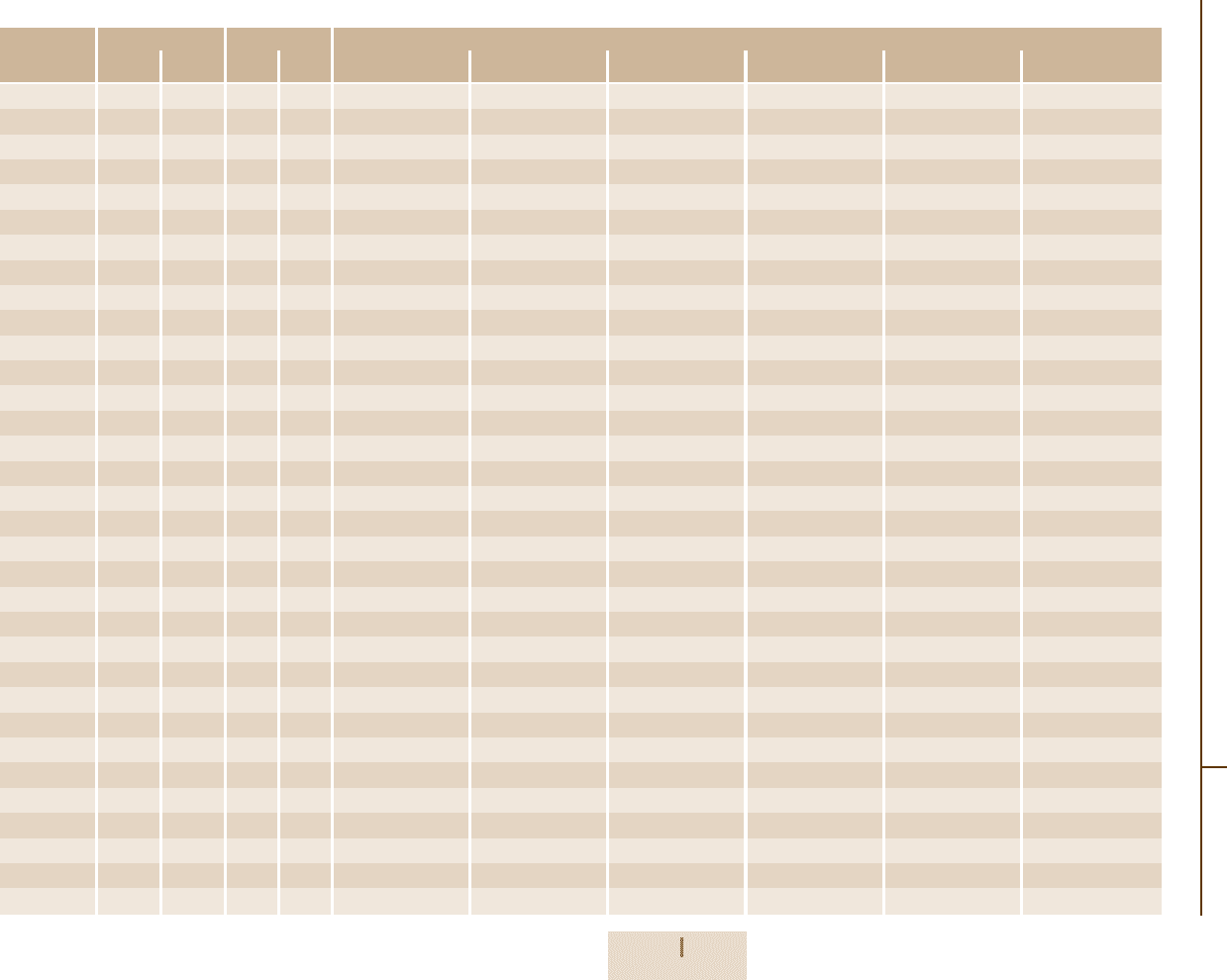
Glasses 4.5 Optical Glasses 551
Table 3.4-16a Properties of optical glasses. Refractive index and Sellmeier constants
Glass Refractive index Abbe value Constants of the Sellmeier dispersion formula
type
n
d
n
e
v
d
v
e
B
1
B
2
B
3
C
1
C
2
C
3
F2 1.62004 1.62408 36.37 36.11 1.34533359 × 10
+00
2.09073176× 10
−01
9.37357162× 10
−01
9.97743871× 10
−03
4.70450767× 10
−02
1.11886764× 10
+02
K10 1.50137 1.50349 56.41 56.15 1.15687082 × 10
+00
6.42625444× 10
−02
8.72376139× 10
−01
8.09424251× 10
−03
3.86051284× 10
−02
1.04747730× 10
+02
LASF35 2.02204 2.03035 29.06 28.84 2.45505861 × 10
+00
4.53006077× 10
−01
2.38513080× 10
+00
1.35670404× 10
−02
5.45803020× 10
−02
1.67904715× 10
+02
LF5 1.58144 1.58482 40.85 40.57 1.28035628× 10
+00
1.63505973× 10
−01
8.93930112× 10
−01
9.29854416× 10
−03
4.49135769× 10
−02
1.10493685× 10
+02
LLF1 1.54814 1.55098 45.89 45.60 1.23326922 × 10
+00
1.16923839× 10
−01
8.62645379× 10
−01
8.85396812× 10
−03
4.36875155× 10
−02
1.04992168× 10
+02
N-BAF10 1.67003 1.67341 47.11 46.83 1.58514950 × 10
+00
1.43559385× 10
−01
1.08521269× 10
+00
9.26681282× 10
−03
4.24489805× 10
−02
1.05613573× 10
+02
N-BAF52 1.60863 1.61173 46.60 46.30 1.43903433 × 10
+00
9.67046052× 10
−02
1.09875818× 10
+00
9.07800128× 10
−03
5.08212080× 10
−02
1.05691856× 10
+02
N-BAK4 1.56883 1.57125 55.98 55.70 1.28834642 × 10
+00
1.32817724× 10
−01
9.45395373× 10
−01
7.79980626× 10
−03
3.15631177× 10
−02
1.05965875× 10
+02
N-BALF4 1.57956 1.58212 53.87 53.59 1.31004128 × 10
+00
1.42038259× 10
−01
9.64929351× 10
−01
7.96596450× 10
−03
3.30672072× 10
−02
1.09197320× 10
+02
N-BASF64 1.70400 1.70824 39.38 39.12 1.65554268 × 10
+00
1.71319770× 10
−01
1.33664448× 10
+00
1.04485644× 10
−02
4.99394756× 10
−02
1.18961472× 10
+02
N-BK7 1.51680 1.51872 64.17 63.96 1.03961212 × 10
+00
2.31792344× 10
−01
1.01046945× 10
+00
6.00069867× 10
−03
2.00179144× 10
−02
1.03560653× 10
+02
N-FK56 1.43425 1.43534 94.95 94.53 9.11957171 × 10
−01
1.28580417× 10
−01
9.83146162× 10
−01
4.50933489× 10
−03
1.53515963× 10
−02
2.23961126× 10
+02
N-KF9 1.52346 1.52588 51.54 51.26 1.19286778 × 10
+00
8.93346571× 10
−02
9.20819805× 10
−01
8.39154696× 10
−03
4.04010786× 10
−02
1.12572446× 10
+02
N-KZFS2 1.55836 1.56082 54.01 53.83 1.23697554 × 10
+00
1.53569376× 10
−01
9.03976272× 10
−01
7.47170505× 10
−03
3.08053556× 10
−02
7.01731084× 10
+01
N-LAF2 1.74397 1.74791 44.85 44.57 1.80984227 × 10
+00
1.57295550× 10
−01
1.09300370× 10
+00
1.01711622× 10
−02
4.42431765× 10
−02
1.00687748× 10
+02
N-LAK33 1.75398 1.75740 52.43 52.20 1.45796869 × 10
+00
5.55403936× 10
−01
1.19938794× 10
+00
6.80545280× 10
−03
2.25253283× 10
−02
8.27543327× 10
+01
N-LASF31 1.88067 1.88577 41.01 40.76 1.71317198 × 10
+00
7.18575109× 10
−01
1.72332470× 10
+00
8.19172228× 10
−03
2.97801704× 10
−02
1.38461313× 10
+02
N-PK51 1.52855 1.53019 76.98 76.58 1.15610775 × 10
+00
1.53229344× 10
−01
7.85618966× 10
−01
5.85597402× 10
−03
1.94072416× 10
−02
1.40537046× 10
+02
N-PSK57 1.59240 1.59447 68.40 68.01 9.88511414× 10
−01
5.10855261× 10
−01
7.58837122× 10
−01
4.78397680× 10
−03
1.58020289× 10
−02
1.29709222× 10
+02
N-SF1 1.71736 1.72308 29.62 29.39 1.60865158× 10
+00
2.37725916× 10
−01
1.51530653× 10
+00
1.19654879× 10
−02
5.90589722× 10
−02
1.35521676× 10
+02
N-SF56 1.78470 1.79179 26.10 25.89 1.73562085 × 10
+00
3.17487012× 10
−01
1.95398203× 10
+00
1.29624742× 10
−02
6.12884288× 10
−02
1.61559441× 10
+02
N-SK16 1.62041 1.62286 60.32 60.08 1.34317774 × 10
+00
2.41144399× 10
−01
9.94317969× 10
−01
7.04687339× 10
−03
2.29005000× 10
−02
9.27508526× 10
+01
N-SSK2 1.62229 1.62508 53.27 52.99 1.43060270 × 10
+00
1.53150554× 10
−01
1.01390904× 10
+00
8.23982975× 10
−03
3.33736841× 10
−02
1.06870822× 10
+02
SF1 1.71736 1.72310 29.51 29.29 1.55912923 × 10
+00
2.84246288× 10
−01
9.68842926× 10
−01
1.21481001× 10
−02
5.34549042× 10
−02
1.12174809× 10
+02
SF11 1.78472 1.79190 25.76 25.55 1.73848403 × 10
+00
3.11168974× 10
−01
1.17490871× 10
+00
1.36068604× 10
−02
6.15960463× 10
−02
1.21922711× 10
+02
SF2 1.64769 1.65222 33.85 33.60 1.40301821 × 10
+00
2.31767504× 10
−01
9.39056586× 10
−01
1.05795466× 10
−02
4.93226978× 10
−02
1.12405955× 10
+02
SF66 1.92286 1.93325 20.88 20.73 2.07842233 × 10
+00
4.07120032× 10
−01
1.76711292× 10
+00
1.80875134× 10
−02
6.79493572× 10
−02
2.15266127× 10
+02
SK51 1.62090 1.62335 60.31 60.02 1.44112715 × 10
+00
1.43968387× 10
−01
8.81989862× 10
−01
7.58546975× 10
−03
2.87396017× 10
−02
9.46838154× 10
+01
K7 1.51112 1.51314 60.41 60.15 1.12735550 × 10
+00
1.24412303× 10
−01
8.27100531× 10
−01
7.20341707× 10
−03
2.69835916× 10
−02
1.00384588× 10
+02
N-SF6 1.80518 1.81266 25.36 25.16 1.77931763× 10
+00
3.38149866× 10
−01
2.08734474× 10
+00
1.33714182× 10
−02
6.17533621× 10
−02
1.74017590× 10
+02
SF6 1.80518 1.81265 25.43 25.24 1.72448482 × 10
+00
3.90104889× 10
−01
1.04572858× 10
+00
1.34871947× 10
−02
5.69318095× 10
−02
1.18557185× 10
+02
N-FK51 1.48656 1.48794 84.47 84.07 9.71247817 × 10
−01
2.16901417× 10
−01
9.04651666× 10
−01
4.72301995× 10
−03
1.53575612× 10
−02
1.68681330× 10
+02
Lithosil
TM
Q 1.45843 1.46004 67.87 67.67 6.69422575 × 10
−01
4.34583937× 10
−01
8.71694723× 10
−01
4.48011239× 10
−03
1.32847049× 10
−02
9.53414824× 10
+01
Part 3 4.5
